Château Guiraud
by
Terry Sullivan
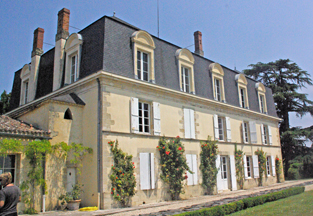 Summary: Designated in 1855 as a Premier Grand Cru de Sauternes, Château Guiraud offers visitors a relaxed visit. Take time to learn about the bio-diversity in the vineyards and organic farming. Discover one of the insect hotels on the property.
Summary: Designated in 1855 as a Premier Grand Cru de Sauternes, Château Guiraud offers visitors a relaxed visit. Take time to learn about the bio-diversity in the vineyards and organic farming. Discover one of the insect hotels on the property.
Pierre Guiraud bought the property in 1766. For several generations the property remained in the family. The château had several owners during the following century. Most recently, it was bought in 2006 by Robert Peugeot, an industrialist, and three winemakers: Olivier Bernard of Domaine de Chevalier, Stephan Von Neipperg of Château Canon La Gaffelière and Xavier Planty. These new owners have a passion for wine, food and nature, and were a perfect match for the estate with 1855 Premier Grand Cru de Sauternes status and vineyards organically farmed.
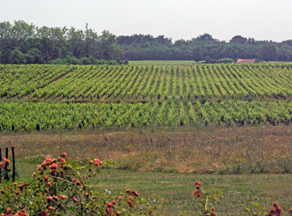 Vineyards
Vineyards
The estate comprises 128 hectares of which 100 hectares (247 acres) are planted with grape vines. Fifteen of those hectares is devoted to making a dry white wine while the remaining 85 hectares is used for making Sauternes. Grapes planted include Semillon and Sauvignon Blanc. Thirty-five percent of the vineyard is planted with Sauvignon Blanc.
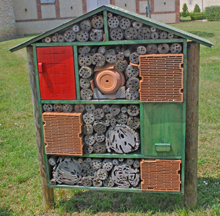 The vineyard is organically farmed. A diverse assortment of wild flowers are planted in the vineyard. Six kilometers of hedges attract a diverse population of insects. A counting in 2010 indicated that there were 675 different kinds of insects. Part art, ten insect hotels were built around the vineyards, one close to the tasting room. These too attract many different insects. A diverse population of insects in a vineyard does not allow harmful insects to get a foothold. Nesting boxes for birds have also been built. As a result of these procedures, pesticides are no longer needed for the vines.
The vineyard is organically farmed. A diverse assortment of wild flowers are planted in the vineyard. Six kilometers of hedges attract a diverse population of insects. A counting in 2010 indicated that there were 675 different kinds of insects. Part art, ten insect hotels were built around the vineyards, one close to the tasting room. These too attract many different insects. A diverse population of insects in a vineyard does not allow harmful insects to get a foothold. Nesting boxes for birds have also been built. As a result of these procedures, pesticides are no longer needed for the vines.
With the help of Xavier Planty, Château Guiraud created a Vine Conservatory on the property. The conservatory makes clones of Semillon and Sauvignon Blanc and grafts them on American rootstock. This insures quality grapevines for future planting and an educational tool for the vine growing community.
Grapes grown for Sauterns are harvested one grape at a time. As the grapes succumb to the fungus, the water content in the grape evaporates and the grapes shrivel up. Not all of the grapes in a cluster get to the raisin stage at the same time. Vineyard workers have to make several passes through the vineyard hand-picking the grapes when they reach the correct stage. Each raisined grape produces two to three drops of juice. An entire vine is need to produce a single glass of Sauterne wine.
Winery
The château produces 150,000 bottles of sweet wine. No sorting tables are used in the winery since grapes are hand-picked, thus sorting takes place in the vineyard. Four pneumatic presses are used to press the grapes. Dry white wines are fermented and aged in barrels. The sweet wines are fermented and aged in barrels. Aging takes two years.
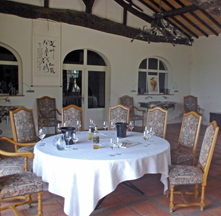 Wines
Wines
We tasted two wines in the large tasting room. Circular tables and chairs were set up for visitors to taste wines. The 2010 Petit Guiraud was a yellow colored blend of Semillon and Sauvignon Blanc. The aroma reminded me of dried fruits, especially pineapple, and the wine had floral notes. The taste was sweet and offered apricots, pineapple, tropical fruits and honey. The finish was fruity with the fruit yielding to nuts. 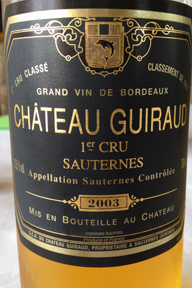 The wine had a long aftertaste. The 2003 Château Guiraud 1er Cru Sauternes was a gold color. The Semillon/Sauvignon Blanc blend had floral and tropical fruits aromas. The taste offered mango, kiwi and honey, while the finish had candied fruits and nuts. The wine would pair well with blue cheese.
The wine had a long aftertaste. The 2003 Château Guiraud 1er Cru Sauternes was a gold color. The Semillon/Sauvignon Blanc blend had floral and tropical fruits aromas. The taste offered mango, kiwi and honey, while the finish had candied fruits and nuts. The wine would pair well with blue cheese.
Many wine tourists like to visit a château that achieved the 1855 Premier Grand Cru de Sauternes status. Château Guiraud is the only vineyard, of that group, organically farmed. Take time to investigat the vineyard, insect hotel and sample the wines.
Château Guiraud
1 Château Guiraud
33210 Sauternes
33 (0) 5 56 76 61 01
Visit these tour operators that partner with Wine Trail Traveler.
 |
||||
France
|
France
|
France | SmoothRed London, England, United Kingdom |


